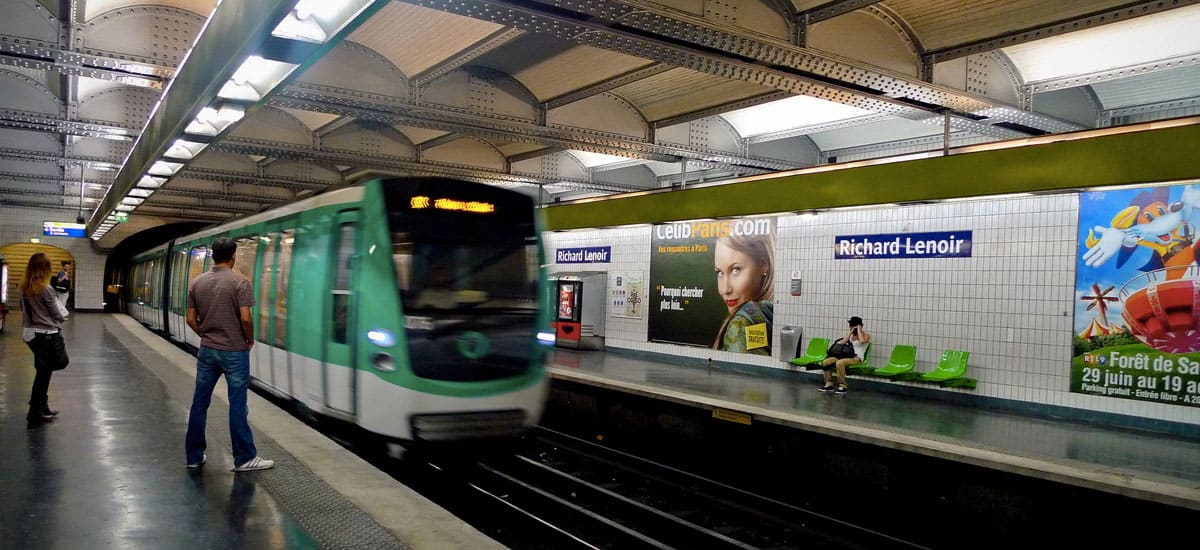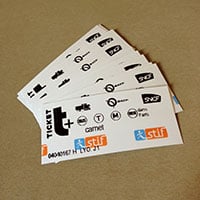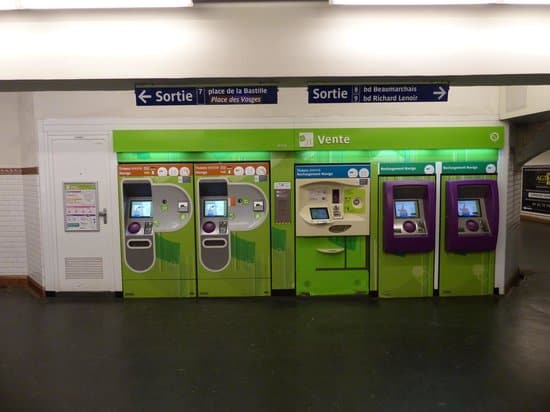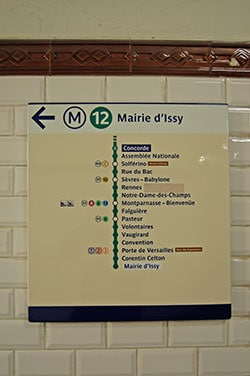
Paris has an excellent underground train network (aka subway) called the Metro. With 16 lines containing over 300 stations throughout the city, the Metro is one of the most compressive metro systems in the world. It also means you’re rarely more than a few minutes walk from a station no matter where you are in the city. Additionally, the metro is well-lit, safe, relatively clean (some stations can be a little smelly), and you rarely have to wait more than 3-4 minutes for a train.
 In most cases it is best to buy a book of 10 tickets called a carnet (€13.70).
In most cases it is best to buy a book of 10 tickets called a carnet (€13.70).
You can also purchase an unlimited one-day ticket (€6.40), an unlimited weekly pass (€20.40), and an unlimited monthly pass (€67). However, with week and month passes you must purchase the card for €5 and attach a passport-sized photo (€5) — so consider those extra costs.
There is also a pass geared for tourists called the Paris Visite but it is rarely a good deal. For most people the carnet is the best option.
Note: All the prices for the tickets and passes listed above are good for zones 1-2 — which covers all of Paris and a little of the surrounding suburbs. Tickets to the airport cost extra.

The easiest place to buy your tickets/passes is inside the metro. Each station has a ticket window and self-service stations. Some of the larger stations have multiple entrances but not all the entrances will have a ticket window. If this is the case, you’ll have to find the main entrance — it should only be about a block away.
North American credit/debit cards won’t work at the self-service machines but you can use them at the ticket window (assuming the worker isn’t on their break). Most stations will also have at least one automated ticket machine that takes coins (not all take cash) so that’s an option. The automated machines are in English and they’re super easy to use.
You can also purchase tickets from Tabacs — small shops that sell tobacco products.

To enter the station you have to insert your metro ticket into the turnstile — hold on to you ticket because ticket checkers hide in the metro stations and randomly check people’s tickets. If you don’t have a ticket you have to pay a fairly hefty fine.
All stations will have a giant map of the entire metro system. The map will have all the lines and all the stops. It will also which lines intersect if you need to change lines. It’s generally smarter to choose a route with the fewest amount of stops, even if there is a route that contains fewer stops.
Most stations only service one or two lines but some of the bigger stations might have multiple lines. There is ample signage so it’s easy to find which platform you need to walk to. Once you find the platform look for signs that list the stops the train will make and be sure your stop is listed.
Each platform will list the terminal stop of the train. Double check a map to make sure your train is going the right direction — if not, just move to the other side of the platform. The entire system is pretty straightforward but it might take a few rides before you feel comfortable using the metro.
The older trains don’t have automatic doors so you’ll have to open them manually. Once on, just find a seat.
New trains have electronic route displays so you know exactly what stop is next. Older trains just have a printed route so pay a little more attention.
During rush hour and at super popular tourist stops, the train can get extremely crowded. If the train is jam packed you might want to wait for the next train since it’s probably coming in two minutes.
The only thing you need to worry about on the metro are pickpockets. They are fairly active (just as in any large city) so be vigilant — wear your bag/purse on your front on crowded trains and make sure it’s zipped or secured. Pickpockets are also very active in the trains stations and they like to target people with lots of luggage since they’re already distracted with all their bags.
Pickpockets (they always work in groups of 2-6+) like to shove themselves onto a overcrowded metro cars at the last minute. This creates a distraction. Sometimes they jump out of the car before the doors close — leaving the victim stuck inside.
Another hot item are smartphones. It’s a good idea to keep the phone hidden away whenever the doors are open because thieves will grab your phone right as the doors are about to close. Also, don’t walk through the metro with your phone out — again, a bunch of kids might come up to you, grab your phone, and all run away. It happens all the time — to tourists and locals alike.
 We hope you’ve found this article helpful. If you have, the best way to say thanks is by clicking on our Amazon.com links.
We hope you’ve found this article helpful. If you have, the best way to say thanks is by clicking on our Amazon.com links.![]() We get a depressingly small commission when you purchase anything on Amazon after you’ve clicked the link — this helps us keep the site running… & maybe buys us a few beers.
We get a depressingly small commission when you purchase anything on Amazon after you’ve clicked the link — this helps us keep the site running… & maybe buys us a few beers.![]() Plus, it doesn’t cost you anything extra! If you’re a student don’t forget to sign up for a FREE year of Amazon Prime.
Plus, it doesn’t cost you anything extra! If you’re a student don’t forget to sign up for a FREE year of Amazon Prime.
Thanks for all your support & click here to learn more about supporting us!